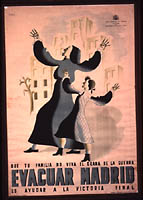 |
Que tu familia no viva el drama de la guerra: Evacuar Madrid es ayudar a la victoria final
[Do not let your family live the drama of the war: To evacuate Madrid is to help in the final victory]. Signed: Girón. Junta Delegada de Defensa de Madrid, Delegación de Propaganda y Prensa. Rivadeneyra CO - Madrid. Sindicato Profesionales Bellas Artes, U.G.T. Lithograph, 3 colors; 100 x 69 cm.
|
|
When Madrid was first
attacked by rebel forces in November 1936, thousands of the city's
inhabitants fled to safety. By the end of November, over 250,000
women, children and seniors-about one-fifth of the city's total
population-had relocated themselves to safer zones in Valencia and
Barcelona. When the fighting stabilized in December, this spontaneous
and voluntary emigration slowed dramatically. In response, the government
of the city, then in the hands of the Junta Delegada de Defensa
de Madrid, waged a campaign to encourage people to leave the
capital. By depicting a woman and her daughter screaming while they
look into the sky as if they see enemy bombers approaching, this
image aims to convey the message that those not essential to the
war effort should leave Madrid.
The need to evacuate
the city was dire for several reasons. First, the population was
much larger than normal because tens of thousands of Spaniards had
poured into Madrid in the early months of the war as the rebels
moved northward through central Spain. As Madrid's inhabitants were
forced to abandon large sections of the city due to fighting, this
increased population pressure was made worse. Perhaps most important
was the fear of high civilian casualties from the heavy bombing
that accompanied Franco's attacks. Despite the dreadful living conditions,
the propaganda campaign was largely ignored by residents of Madrid
who continued to wait in ration lines to buy everything from bread
to wood and who witnessed daily the destruction of their city and
the deaths of their loved ones. In December 1936, the Republican
government mandated that all inhabitants of the city who had arrived
after July 19, 1936 and were not essential to the war effort must
leave. A month later, the government called for a more complete
evacuation by eliminating the date of arrival clause, so that even
long-time residents of Madrid had to go. Even after these measures,
only 5,000 people left Madrid daily.
Contemporary explanations
for the reluctance of madrileños to relocate included unwillingness
to lose their homes and belongings, and fear of being separated
from loved ones. In his memoirs, one contemporary recalls with frustration
the resistance to the evacuation: "The display of heroism by
the civilian population, sacrificing themselves futilely, bordered
on stupidity."
This poster was distributed
between mid-December 1936, when the government of Madrid began its
intensive effort to evacuate the city, and April 1937, when the
issuing entity was dissolved. Little is known of the designer Girón,
other than he worked for the Junta Delegada de Defensa de Madrid
and the Ministerio de Propaganda.
|




